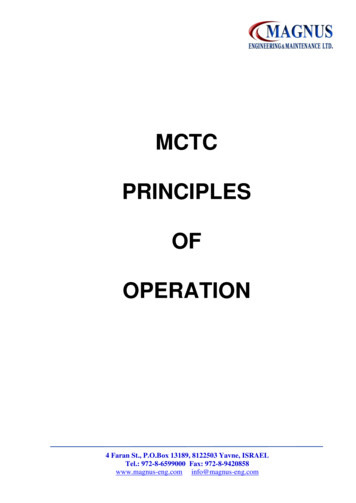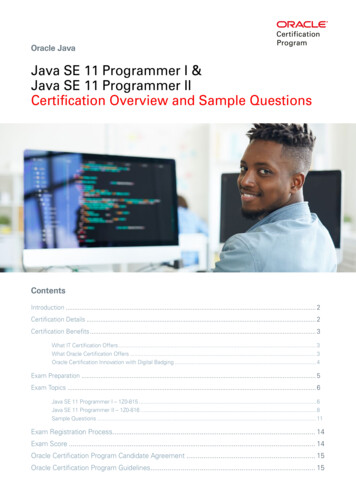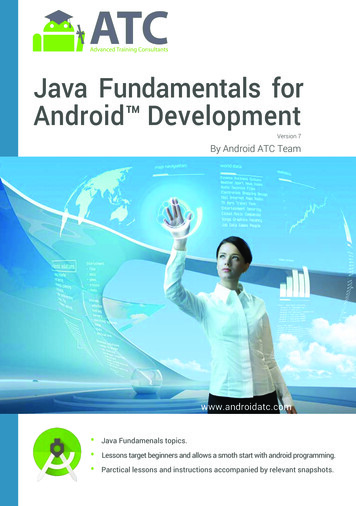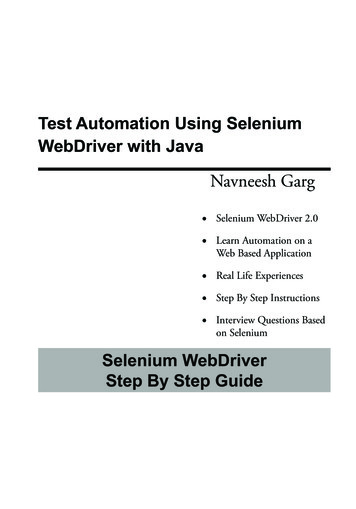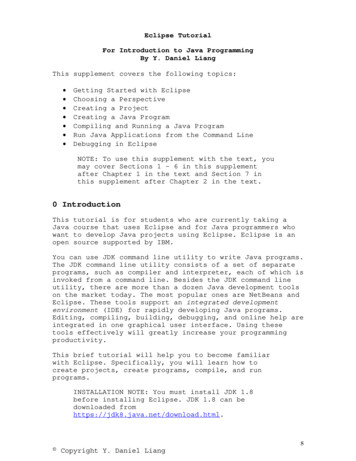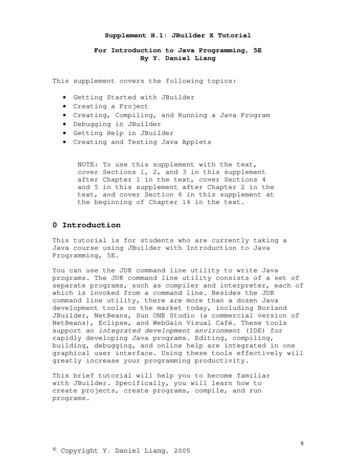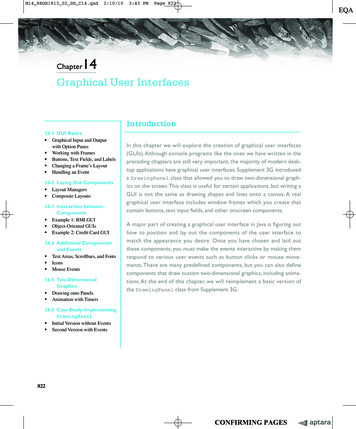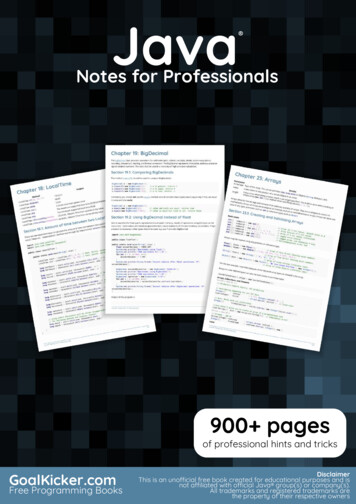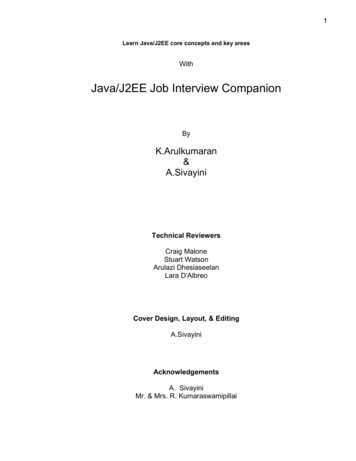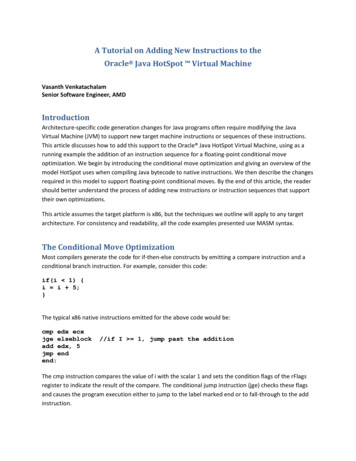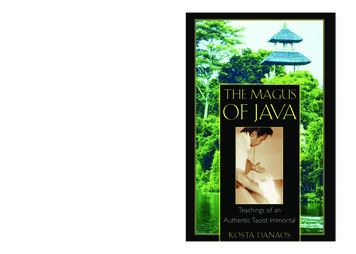
Transcription
16.95KOSTA DANAOS is a former engineer forGeneral Dynamics, a martial arts instructor injujutsu and tai ch’i chuan, and a freelance writerwith more than 150 publications to his credit.When not traveling in Indonesia or the UnitedStates he lives in Athens, Greece.Inner TraditionsRochester,VermontCover design by Peri ChampineBackground cover photograph courtesy of PictureQuestTHE MAGUS OF JAVAIn 1988 the documentary Ring of Fire was released to great acclaim. The moststartling sequence in the film is that of a Chinese-Javanese acupuncturist whodemonstrates his full mastery of the phenomenon of ch’i, or bio-energy, by firstgenerating an electrical current within his body, which he uses to heal the filmmaker of an eye infection, and then setting a newspaper on fire with his hand. Ringof Fire caused thousands to seek out this individual, John Chang, in pursuit ofinstruction. Of the many Westerners who have approached him, John Chang hasaccepted five as apprentices. Kosta Danaos is the second of those five.In his years of study with John Chang, Danaos has witnessed and experiencedpyrokinesis, telekinesis, levitation, telepathy, and much more exotic phenomena.He has spoken with spirits and borne witness to the afterlife. Most important, hehas learned John Chang’s story. John Chang is the direct heir to the lineage ofthe fifth-century B.C. sage Mo-Tzu, who was Confucius’s greatest rival. His discipline, called the Mo-Pai, is little-known in the West and has never before been thesubject of a book. Now, John Chang has decided to bridge the gap between Eastand West by allowing a book to be published revealing the story of his life, histeachings, and his powers.The Magus of Java is the story of Kosta Danaos’s apprenticeship with JohnChang, and it is the story of the Mo-Pai, who for the past 2000 years have kepttheir teachings secret. Included are scientific, physics-based explanations ofChang’s paranormal abilities that we in the West consider impossible—abilitieswitnessed by the author and vividly described. The Magus of Java will surely expedite what may well become the greatest revolution of the twenty-first century—the verification and study of bio-energy.DANAOSEastern Philosophy/TaoismTHE MAGUSOF JAVATeachings of anAuthentic Taoist ImmortalPRINTED AND BOUND IN CANADAKOSTA DANAOS
John Chang in meditation.iiIntroduction
THE MAGUSOF JAVATeachings of an Authentic Taoist ImmortalKOSTA DANAOSInner TraditionsRochester, VermontiiiIntroduction
For DorisInner Traditions InternationalOne Park StreetRochester, Vermont 05767www.InnerTraditions.comCopyright 2000 by Kosta DanaosAll rights reserved. No part of this book may be reproduced or utilized in anyform or by any means, electronic or mechanical, including photocopying,recording, or by any information storage and retrieval system, without permissionin writing from the publisher.Library of Congress Cataloging-in-Publication DataDanaos, KostaThe Magus of Java : teachings of an authentic Taoist immortal / Kosta Danaos.p. cm.Includes bibliographical references.eISBN-13: 978-1-59477-877-31. Chang, John. 2. Taoists—Indonesia—Java—Biography. 3. Healers—Indonesia—Java—Biography. I. Title.BL1940.C426 D36 2000299’.514’092—dc21[B]00-036942Text design and layout by Crystal H. H. RobertsThis book was typeset in Weiss with Schneidler Initials as the display typefaceivIntroduction
CONTENTSIntroductionviiChapter OneLooking through the MirrorChapter TwoLifeforce12Chapter ThreeBeginnings24Chapter FourThe Immortals35Chapter FiveThe Story of Liao Sifu61Chapter SixLessons to Be Learned76Chapter SevenYin and Yang99Chapter EightThe Will of Heaven116Chapter NineThe Keris133Chapter TenThe Nature of Reality147EpilogueFor a Breath I Tarry. . . .162Appendix OneNotes177Appendix TwoObservations and Speculation200v1
This page intentionally left blank.
IntroductionImagine a world where the mind and soul of man are free to reachtheir greatest potential, where powers once considered supernaturalor paranormal are a simple fact of life. Imagine a place where diseases hitherto thought incurable can be treated with the uncomplicated administration of the healer’s own abundant life energy, a placewhere mankind can readily communicate with earthbound spirits,where powerful yogis can speak with their Creator God Himself.Wouldn’t it be wonderful to dwell in such a domain, the stuff of fairytales, myths and legends, storybooks, and Hollywood celluloid?Wouldn’t life have a distinct flavor, a tangy zest, if such things wereindeed true?Welcome to my world. I live in such a place, where all the extraordinary things that I have suggested are real and incontrovertible. In my world Western science and Eastern mysticism walk handin hand, embraced and inseparable, mirror aspects of the same reality, equally factual and valid. The opportunity to grow is there everywaking moment, the gift of our own great potential.You might suppose that such a destiny is far away, but in truth itis at mankind’s doorstep. There can be no doubt that humanity isonce again in the process of changing. Traditions are evolving ascross-cultural barriers continue to fall. Old values, ideals, and concepts are no longer blindly accepted; people of all creeds, races, andnations have become less hesitant to question, to ask why.vii
The mind of man is in a frenzy as never before, technology growing logarithmically by leaps and bounds. We have set foot on themoon and touched the bottom of the ocean. We have moved at manytimes the speed of sound and have viewed the faces of the planetsaround us. We control the power of the atom and can replace acrippled human heart with that of a suitable (and willing) donor. Weare a step away from creating an artificial, silicon-based intelligence.We have even invaded the sanctity of the gene and created clones. Itseems that our quest for knowledge is constrained only by energy,time, and financial allocation.We have made much social progress. Despite discriminatory distribution, education levels are at an all-time high for the human race.The phenomenon of human serfdom and subjugation is on the wane;rebellion is evident all over the world. People are aware of their rightsand are willing to fight—perhaps even to die—for them. (No simplething, this, when you consider that the economies of all historicempires were founded on slavery.) Even more stirring is the fact thatmany individuals are now willing to fight and die for other people’srights, perhaps more so than in any other period in our history. Whatis equally important is that the self-sacrifice of these heroes is notbased on any specific religious belief or practice, but rather on thesimple conviction that human rights deserve to be protected.There is a backlash to this, of course. Ethnic and religious fanaticism is on the rise. Fascism troubles us once more. Multinational corporations abuse their power at will for greater profits, bribing corrupt governments to rape their land and use their own citizens. Theplanet’s ecological balance has been destroyed—permanently, somepeople claim. Our flora and fauna are dying, the planet suffering.The Almighty Dollar rules, and consumerism is the creed of the day.It seems that for all our power—for we are powerful—we haveyet to answer the fundamental questions of life. Who are we? Where arewe going? Why are we here? What are our inherent capabilities, what our finalpotential? Do we live on after death, as is believed? What is true happiness and howcan we reach it? Is there, indeed, a Creator God? The list is endless, as old asman himself.It is possible for us to answer these questions. The secret to a successful resolution of these basic inquiries, however, is that we mustviiiIntroduction
make a committed effort as a species, not as nations or groups of people,to find the answers. The method required is as simple, and as difficult, as that.Humanity has developed along many different lines. There areas many cultural approaches to life as there are natural and sensorystimuli. Some cultures are visual, others acoustic, others olfactory,others intuitive. It is hard to quantify human culture with precision,and such an analysis is far beyond the scope of this book. However,it is possible to say (speaking very generally) that, as a dominanttendency, Western science has turned outward, its intent being toquantify and modify man’s environment to suit man’s wishes. Easternscience, on the other hand, has turned inward, attempting to quantify and develop the innate capabilities of the human species andunderstand its role in the scheme of things. While it is very dangerous and unscientific to make statements of this sort, for the timebeing it is important that I take this standpoint, if for no other reason than to clarify the purpose of this text.Let me return to the phrase a committed effort as a species. This statement implies that we human beings must pierce through our ethnicand national barriers and work together. History tells us that incredible events have unfolded whenever we were able to temporarilycross our self-imposed thresholds. The Hellenistic Age, for example,clearly shows us what can be achieved through cultural interaction;in the fourth century BCE ancient Greece met with ancient India, andthe destiny of the world was forever, and quite radically, changed.1The exploits of King Alexander and his men, however, are notdirectly pertinent to this book. The point is, there is no reason thatwe today cannot duplicate what the ancients achieved then, and thatis to learn from each other in order to grow, to survive, perhaps evento thrive. In the nineteenth century Kipling wrote, “East is East andWest is West, and never the twain shall meet.”* He was wrong. East ismeeting West today, and will continue to do so if we can just nurturetheir union. To realize this, we must ensure that both cultures———————1. See appendix 1 for this and all other numbered notes.* Rudyard Kipling, “The Ballad of East and West,” 1889.ixIntroduction
approach each other with mutual respect, open themselves completelyto each other, and share their conclusions. It is not an easy task.Chinese culture, and more specifically Taoist culture, has takenthe West by storm. Acupuncture is practiced everywhere. Chineserestaurants are ubiquitous. Kung fu movies and TV shows are popular far and wide. Meditation has been recognized as a bio-behavioralstate by Western medicine.* The Tao Te Ching is being read byuniversity students all over the world, and many Western businessmen are using the I Ching and feng shui (Chinese divination methods) in their day-to-day decision making.And yet, despite the popular appeal of Chinese Taoist culture, afine fusion of East and West has only begun to take place in recentyears. For the most part, people in the West either entirely reject theEastern approach as mumbo-jumbo or embrace it with religious fervor as more ancient and spiritual than Western science. Both of theseattitudes are erroneous. The first presumptuously rejects the value ofChinese learning; the second takes tried and proven biophysical techniques developed over millennia and turns them into dogma. Thisproblem is compounded by the fact that many Westerners and Chinese alike are too eager to push what little tidbits of knowledge theyhave down consumers’ throats in a desperate quest for money.The Chinese themselves are responsible for much of this. Thereis, unfortunately, no such thing as Chinese science. Instead, there arefamily and clan sciences and arts developed by the people of the Chinese nation over millennia. The knowledge developed by the Chinesewas never widespread, not even within China itself. It was the prerogative and the power base of the privileged few and their families.In the past a Chinese Master never taught his apprentices 100percent of his knowledge. Instead he retained, say, the foremost 10percent for himself alone. Perhaps he would write down the rest ina document for his favorite student, to be opened after his death.The result of this approach was that the sum of each clan’s learningdecreased by 10 percent with each generation, until some charismatic student was able to decipher the mystery and return to the———————* Herbert Benson, The Relaxation Response (New York: William Morrowand Co., 1975).xIntroduction
status of the original teacher, at which point the cycle went onwith his students, and so forth. The capabilities and exploits of theMasters became the stuff of legend, and later the storyline of theChinese opera. Today they are the essence of all kung fu movies.To make matters worse, the Masters almost never worked together. The concept of a Western university, where knowledge isshared and experiences are compared, was an alien one for them.Power was meant to be used for profit, material and spiritual. Moreoften than not martial Masters challenged each other; much knowledge was forfeited in this manner because the bested Master frequently lost his life as well. To our Western culture, such an approach seems shocking, to say the least. Information disseminationis evident everywhere; indeed, it is very difficult, even undesirable,to keep knowledge secret or proprietary in our society.2Yet there is a way that a complete union of these two culturescan be accomplished, and that is simply by the creation of a newscience that is neither Eastern nor Western but a union of both. Boldvisionaries of generations past have foretold such a discipline. I believe that it is mankind’s destiny to come together in this fashion,and that such a science, combining the orthological* approach ofthe West with the mystical discipline of the East, is being forged inour day and age. This story, in essence, represents the future direction chosen by humanity’s awakening desire for a better life and ahigher truth. You will find many parallels with readily available existing texts. The main difference, however, between this book andany other is that it is
The Magus of Javais the story of Kosta Danaoss apprenticeship with John’ Chang, and it is the story of the Mo-Pai, who for the past 2000 years have kept their teachings secret. Included are scientific, physics-based explanations of Chang’s paranormal abilities that we in the West consider impossible—abilities
